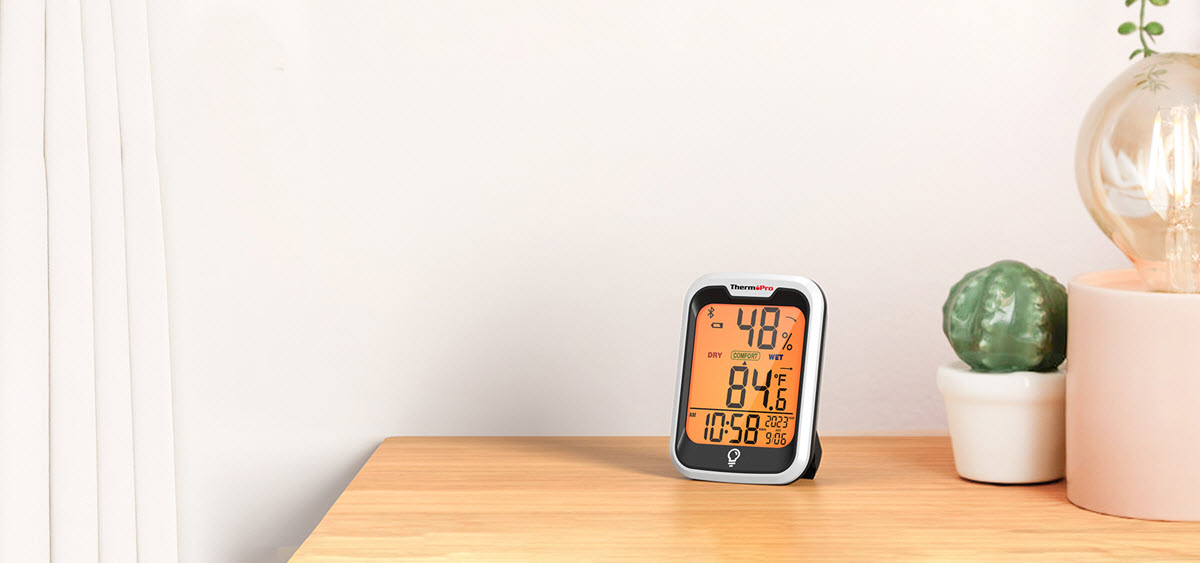Spring brings warmer weather, blooming flowers, and the promise of outdoor fun. But for many, it’s also the start of allergy season, with symptoms like sneezing, runny noses, and itchy eyes.
If you’re one of those people, you’re probably already dreading the effects of spring allergies. However, there’s an unexpected ally that can help you survive the season: a hygrometer. A hygrometer can help you monitor the humidity and temperature levels in your home, which can have a significant impact on your allergy symptoms.
In this article, we’ll explore how using a hygrometer can help manage spring allergies and why investing in a quality device could make all the difference.

Understanding Spring Allergies
Spring allergies are caused by pollen from trees, grasses, and flowers. When these allergens enter the air, they can trigger symptoms like sneezing, coughing, watery eyes, and congestion. Additionally, spring is a time of changing weather, which can increase the amount of moisture in the air.
This higher humidity, combined with fluctuating temperatures, can create an environment that promotes the growth of mold and dust mites—two common indoor allergens. That’s where monitoring your indoor environment can make a big difference.
Why Humidity Matters for Spring Allergies
Humidity is a key factor in controlling allergy symptoms. High humidity can make the air feel heavy, which can worsen respiratory problems for those with allergies. Additionally, moist environments are perfect for mold and mildew growth, which can exacerbate allergy symptoms.
On the other hand, low humidity can dry out your nasal passages and make it harder to breathe. Having the right balance of temperature and humidity in your home can help reduce allergy flare-ups and improve your overall comfort during the spring months.
One simple way to monitor and control the humidity in your living space is by using a digital hygrometer. A hygrometer is a device that measures the moisture levels in the air, and when paired with a thermometer, it gives you a complete picture of your indoor environment.
The Benefits of Using a Hygrometer for Allergy Relief
Using a hygrometer can help you stay on top of your home’s environment during allergy season. By monitoring both the temperature and humidity, you can:
- Maintain Optimal Humidity: Humidity levels between 30-50% are ideal for comfort and allergy relief. A hygrometer helps you keep track of this and adjust accordingly.
- Prevent Mold and Mildew Growth: Mold thrives in humid environments. Keeping an eye on humidity levels can help you take action before mold becomes a problem.
- Improve Breathing Conditions: Optimal humidity prevents your nasal passages from drying out, making it easier to breathe and reducing irritation.
- Avoid Allergy Flare-Ups: Knowing when conditions in your home are triggering your allergies allows you to make changes before symptoms worsen.
Introducing the ThermoPro TP358 Bluetooth Indoor Thermometer & Hygrometer
The ThermoPro TP358 Bluetooth Indoor Thermometer & Hygrometer is an excellent choice for anyone looking to take control of their indoor air quality during allergy season. This device combines temperature and humidity monitoring with Bluetooth 5.0 technology, making it easy to keep track of your home’s environment remotely. Let’s take a closer look at its features.
Key Features of the ThermoPro TP358
Below are some key features you will get in the ThermoPro TP358:
- High Accuracy & Real-Time Updates: Provides precise temperature and humidity readings, refreshing data every 10 seconds.
- Long Bluetooth Range (260 ft / 80 m): Monitor conditions from up to 260 feet away, ideal for large spaces.
- Custom Alerts for Temperature & Humidity: Set custom limits in the app to receive notifications when conditions fall outside your preferred range.
- Data Tracking & Export: Stores up to 2 years of data with export functionality for long-term tracking and analysis.
- Backlit LCD Display with Clock & Date: 3-inch backlit display showing temperature, humidity, time, and date for easy viewing day or night.
- Comfort Level Indicator: Indicates whether indoor air conditions are Dry, Comfort or Wet, helping maintain ideal air quality.
- Versatile Placement Options: It can be placed on a tabletop, mounted on a wall, or attached magnetically for flexible placement.
- Power Efficient: Operates on 2 AAA batteries (3.0V) for long-lasting, low-maintenance use.
Ideal Use Cases for the ThermoPro TP358
- Nurseries: Ensure a comfortable environment for your baby by monitoring temperature and humidity levels.
- Bathrooms: Prevent mold growth and ensure the air remains fresh and comfortable.
- Living Rooms: Maintain a healthy atmosphere in your home’s common areas.
- Greenhouses: Optimize temperature and humidity levels for your plants’ health.
- Bedroom: Help create an ideal sleeping environment
By keeping track of both the temperature and humidity in your home, the ThermoPro TP358 helps you create the ideal indoor environment for managing your spring allergies.
Conclusion
If you have spring allergies, you can minimize their impact on your daily life with the right tools. A digital hygrometer, like ThermoPro TP358 Bluetooth Indoor Thermometer & Hygrometer can help you monitor and adjust the temperature and humidity in your home to keep your allergies under control. In order to enjoy the spring season to the fullest, keep your indoor environment clean and comfortable and maintain optimal humidity levels. A simple device like this can help you manage allergies regardless of whether you have mold, dryness, or fluctuating temperatures.


















